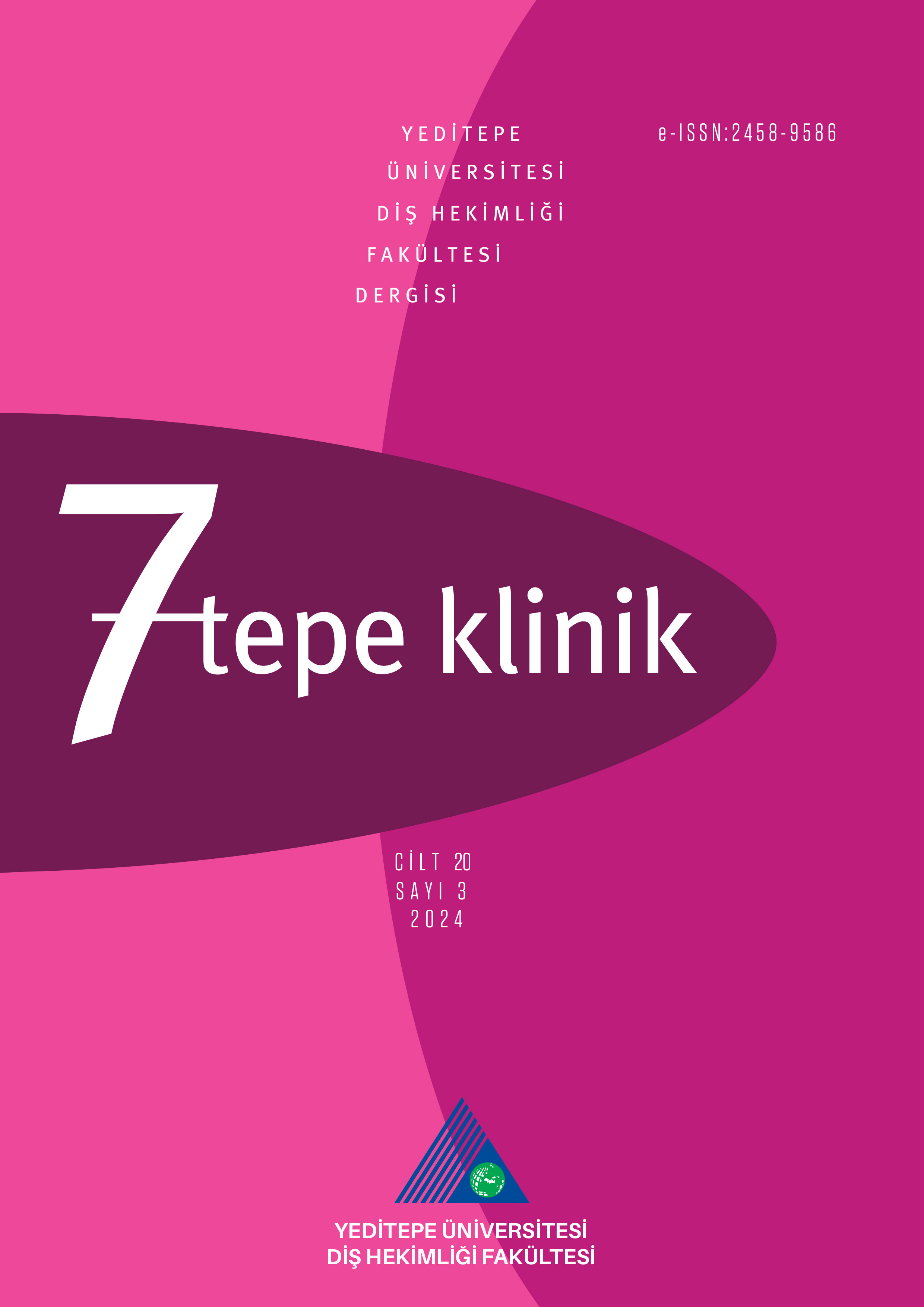Farklı yüzey işlemi uygulanan porselen dişler ve kaide-tamir materyalleri arasındaki gerilme kuvvetinin değerlendirilmesi
Murat Alkurt1, Zeynep Yeşil Duymuş1, Mustafa Gündoğdu21Recep Tayyip Erdoğan Üniversitesi, Protetik Diş Tedavisi Ana Bilim Dalı, Rize2Atatürk Üniversitesi, Protetik Diş Tedavisi Ana Bilim Dalı, Erzurum
GİRİŞ ve AMAÇ: Bu çalışmanın amacı, porselen protez dişelere uygulanan farklı yüzey işlemlerinden sonra iki farklı protez kaide (poliamid ve ısı ile polimerize akrilik) ve tamir materyali (otopolimerize akrilik) ile arasındaki gerilme kuvvetini değerlendirmektir.
YÖNTEM ve GEREÇLER: Bu çalışmada 63 adet aynı şekil ve renk mandibular sağ birinci molar porselen protez dişleri kullanıldı. Birinci molar porselen protez dişler 3 materyal grubuna ayrıldı; Grup 1: Isı polimerizasyonu (HP), Grup 2: Otopolimerize akrilik (AP) ve Grup 3: Poliamid (PA) (n=21). Daha sonra, tüm poselen dişler yüzey işleme yöntemine göre 3 alt gruba ayrıldı; Kontrol, Kumlama, Er: YAG lazer. Gerilme kuvveti (MPa) universal test makinesi kullanılarak (0.5 mm/dak) tespit edildi. Gerilme değerlerinin ortalama ve standart sapması hesaplandı ve tüm veriler two-way ANOVA ve post-hoc Tukey HSD ile analiz edildi. Güven aralığı α=0.05 olarak belirlendi. Yüzey işlemlerinin etkileri taramalı elektron mikroskobu (SEM) ile incelendi.
BULGULAR: Poliamid kaide materyali diğer materyallere göre önemli derecede yüksek gerilme değeri sağladı (p<0,05). En yüksek gerilme değeri, lazer işlemi uygulanan porselen yüzeyler ile poliamid kaide materyali (9,89 MPa) arasında bulundu. En düşük gerilme değeri, otopolimerize akrilik tamir materyalinin kontrol grubu (6,38 MPa) olarak belirlendi. Uygulanan yüzey işlemleri istatiksel anlamlı bir fark göstermedi (p>0,05).
TARTIŞMA ve SONUÇ: En fazla gerilme kuvveti poliamid kaide materyalinde bulunmuştur. Farklı yüzey uygulamalarının porselen dişlerin gerilme değerlerini etkilemediği görülmüştür.
Assessment of tensile strength between base-repair materials and porcelain teeth subjected to different surface treatment
Murat Alkurt1, Zeynep Yeşil Duymuş1, Mustafa Gündoğdu21Recep Tayyip Erdoğan University, Faculty of Dentistry, Department of Prosthodontics, Rize2Atatürk University, Faculty of Dentistry, Department of Prosthodontics, Erzurum
INTRODUCTION: The purpose of study is to assess the tensile strength between porcelain teeth and two different denture base (polyamide and heat-polymerized acrylic), a repair material (auto-polymerizing acrylic) after different types of surface treatment.
METHODS: Total of 63 same form and color mandibular right first molar porcelain denture teeth were used. The first molar porcelain denture teeth were separated into 3 material groups; Group 1: Heat-polymerized (HP), Group 2: Autopolymerizing (AP), and Group 3: Polyamide (PA) (n=21). Then, all material groups were divided into 3 subgroups (n=7) representing different surface treatment method; Control, Airborne abrasion, Er: YAG laser. A universal testing machine was used for determining the tensile bond strength (MPa) of the porcelain denture teeth to surface treated denture base and repair materials. The crosshead speed was set of 0.5 mm/min. Two-way ANOVA and post-hoc Tukeys HSD was used for statically analyses (α=0.05). The effects of the surface treatment were observed by scanning electron microscopy (SEM).
RESULTS: The polyamide (PA) has significantly higher (p< 0.05) tensile bond strength than the Heat-polymerized (HP) and Auto-polymerizing acrylic (AP). Polyamide (PA) with laser surface treatment (9.89 MPa) showed highest tensile bond strength. The lowest tensile bond strength was determined control group (6.38 MPa) of auto-polymerizing (AP). Surface treatments showed no significant difference.
DISCUSSION AND CONCLUSION: Superior tensile strength was found polyamide denture base and different surface treatments not affect the tensile strength of porcelain teeth.
Makale Dili: İngilizce



